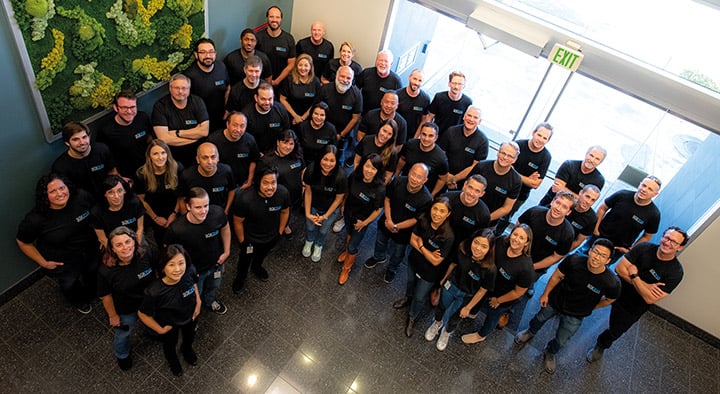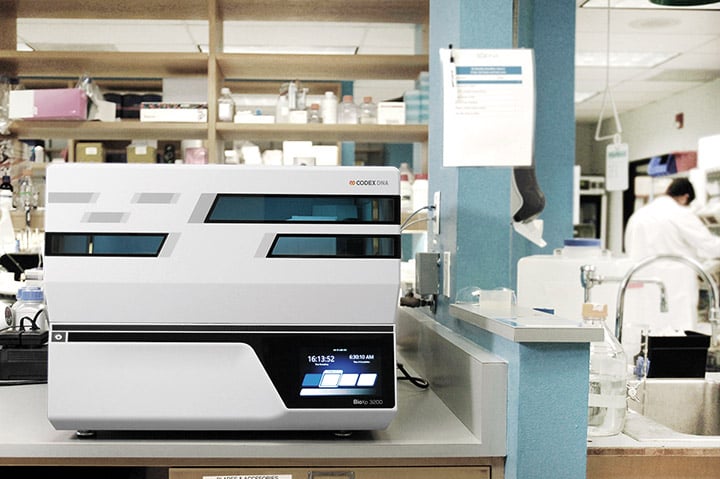The COVID-19 pandemic sweeping the globe has highlighted the need for the rapid development of new diagnostic tests, therapeutics and vaccines in response to emerging infectious diseases. Advanced gene assembly techniques represent a powerful tool to aid these efforts, and are currently allowing the construction of synthetic SARS-CoV-2 genomes for research and development activities. Codex DNA is at the forefront of this approach, using its knowhow and BioXp™ 3200 system to supply labs across the globe with the gene constructs required to accelerate the design and optimization of vaccines and treatments.
Gibson Assembly® is now one of the most commonly used molecular cloning methods around the world, allowing multiple DNA fragments to be joined in a single, isothermal reaction. It led to the development of the first synthetic gene and the first synthetic cell, but it was during the emergence of H1N1 influenza (swine flu) that a more translational application for this technology came to light. The risk of an H1N1 influenza pandemic underscored the need for ready access to genome constructs to develop effective vaccines.

The Codex DNA team (NOTE: Photo taken prior to social distancing)
Dr Dan Gibson, inventor of the Gibson Assembly method and Chief Technology Officer at Codex DNA, was approached by the pharmaceutical industry to develop a system that would allow the rapid production of synthetic H1N1 genome constructs. That request eventually became the BioXp 3200 system. Brian Donnelly, Chief Commercial Officer at Codex DNA, filled in the details: “When Dan was asked to create large libraries of constructs with the speed and precision required to address the potential H1N1 influenza pandemic, he immediately opted for an automated system. That platform was effectively an early prototype of the BioXp 3200 system. We then set about developing this device into a robust and reliable automated instrument for widespread deployment in labs across the globe.”
Laurence Warden, Codex DNA’s Vice President of Engineering and Instrumentation, took up the story: “I came on board specifically to develop the BioXp system, as the company had a lot of molecular biology expertise, but didn’t have the necessary instrument development experience. We decided to undertake the entire system development project in house, creating a platform from the ground up, including the housing, thermal cyclers, chillers, etc. The one exception to this was the liquid handling components. Our protocols require several liquid transfers, ranging from just three or four microliters up to 180, and we knew from experience that it would be challenging to develop an accurate and reliable pipettor for this application.”
This rapid turnaround time has been vital in accelerating vaccine development research in the current COVID-19 crisis.
“We looked at the OEM liquid handling technologies available, and the Cavro® Air Displacement Pipettor (ADP) from Tecan ticked all the boxes. It is very compact, provides built-in tip ejection capabilities and, crucially, offers pressure-based liquid level detection (pLLD). Although the ADP was very new at the time, we had previous experience with Tecan liquid handling platforms and OEM pump technologies, so we were confident that it would be well built and reliable. Although there were a few challenges early in the integration process, Tecan’s engineers worked with us to develop an improved power filtering strategy, and we haven’t suffered from these problems again – our test rigs have completed over three times the number of runs outlined in our design specification.” “The ADP’s pLLD capabilities have allowed us to create an automated calibration algorithm to determine the correct Z-height for each pipetting step. This pressure sensing function has also proved very useful as an analytical tool. If there is an issue during nucleic acid processing, we can go back and look at the data logs for every pipetting step to see if there is a pressure spike due to, for example, a piece of foil or debris occluding a tip during aspiration. This ability to pull pressure logs and error codes is extremely beneficial for troubleshooting, and we haven’t fully explored all the options the ADP offers yet. We certainly wouldn’t have been able to replicate such an intelligently designed and sophisticated system in the accelerated timeframe we needed. Using the ADP, it took just 18 months from the start of the project to the production of the first instrument.”

The BioXp 3200 system
The BioXp 3200 system was launched in 2015, allowing labs to build up to 32 complex constructs in a single overnight run. With an ever-growing global install base of hundreds of systems, Codex DNA and the BioXp system have been perfectly positioned to help labs investigating the SARS-CoV-2 virus and developing novel vaccines. Brian continued: “A unique feature of our system is that every single reagent cartridge is completely custom. Our customer chooses the gene sequences they want, and places an order via our online portal. We then design and build the cartridge to make their target genes, and ship it to their lab. When the customer inserts the cartridge into the system, the platform automatically runs the correct protocol and generates the desired constructs – doing in a few hours or days what would take scientists weeks or months to do manually. Thanks to our in-house bioinformatics capabilities and DNA design expertise, the entire process – from placing an order to shipping –usually takes less than 24 hours. This rapid turnaround time has been vital in accelerating vaccine development research in the current COVID-19 crisis, and we received several orders for construct libraries within a few days of the first whole SARS-CoV-2 genome sequence being published.”
To find out more about Tecan’s ADP, visit www.tecan.com/components
To learn more about Codex DNA, go to www.codexdna.com
Keywords:









